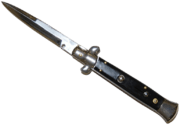Fisher v Bell
| Fisher v Bell | |
|---|---|
 | |
| Court | High Court |
| Decided | 10 November 1960 |
| Citation(s) | [1961] 1 QB 394, [1960] 3 All ER 731 |
| Keywords | |
| Contract, offer, invitation to treat, display of goods for sale, shop window, offensive weapons | |
Fisher v Bell [1961] 1 QB 394 is an English contract law case concerning the requirements of offer and acceptance in the formation of a contract. The case established that, where goods are displayed in a shop together with a price label, such display is treated as an invitation to treat by the seller, and not an offer. The offer is instead made when the customer presents the item to the cashier together with payment. Acceptance occurs at the point the cashier takes payment.
Facts
The Defendant displayed a flick knife in the window of his shop next to a ticket bearing the words "Ejector knife – 4s." Under the Restriction of Offensive Weapons Act 1959, section 1(1), it was illegal to manufacture, sell, hire, or offer for sale or hire, or lend to any other person, amongst other things, any knife "which has a blade which opens automatically by hand pressure applied to a button, spring or other device in or attached to the handle of the knife". On 14 December 1959, the Claimant, a chief inspector of police force, brought forward information against the Defendant alleging the Defendant has contravened section 1(1) by offering the flick knife for sale. This loophole was closed by Restriction of Offensive Weapons Act 1961 [1] Ban on Flick Knives: which inserted after the words “offers for sale or hire” the words “ or exposes or has in his possession for the purpose of sale or hire”."
Held
High Court
At first instance, the Prosecutor submitted that the Defendant has displayed the knife and ticket in the window with the object of attracting a buyer, and that this constituted an offer of sale sufficient to create a criminal liability under section 1(1) of the Act. The Defendant submitted that this was not sufficient to constitute an offer. The judges at first instance found that displaying the knife was merely an invitation to treat, not an offer, and thus no liability arose. The Prosecutor appealed the judges' decision.
Court of Appeal
The court upheld that, although the display of a knife in a window might at first appear to "lay people" to be an offer inviting people to buy it, and that it would be "nonsense to say that [it] was not offering it for sale", whether an item is offered for the purpose of the statute in question must be construed in the context of the general law of the country. He stated that the general law of the country clearly established that merely displaying an item constituted an invitation to treat. He also read the statute on an exclusive construction (inclusio unius est exclusio alterius), noting that other legislation prohibiting the sale of weapons referred to "offering or exposing for sale" (emphasis added). The lack of the words exposing for sale in the Restriction of Offensive Weapons Act 1959 suggested that only a true offer would be prohibited by the Act. The court dismissed the appeal. Goods displayed in a shop are merely an invitation to treat or invitation to trade.
See also
- Contract
- Offer and acceptance
- Invitation to treat
- Partridge v. Crittenden (for an instance of an advertisement as an invitation to treat)
- Pharmaceutical Society of Great Britain v. Boots Cash Chemists (Southern) Ltd. (for an instance of products on a self-service shelf as an invitation to treat) [1953] 1 QB 401, [1953] 2 WLR 427, [1953] 1 All ER 482